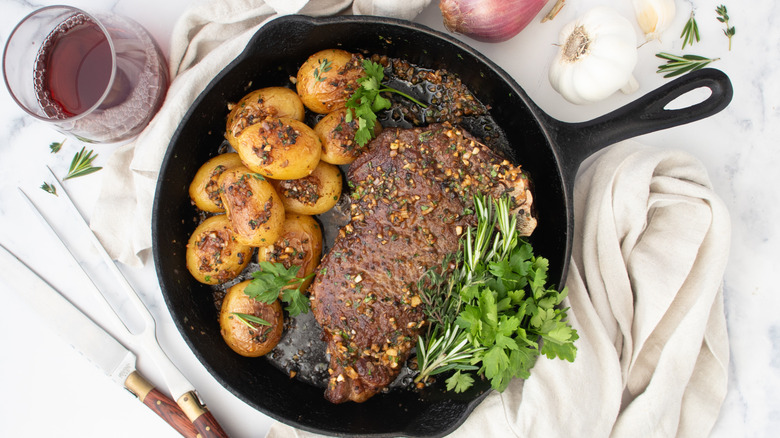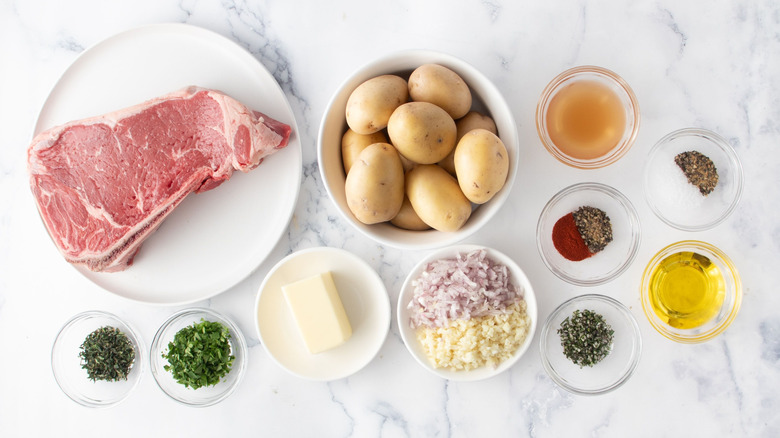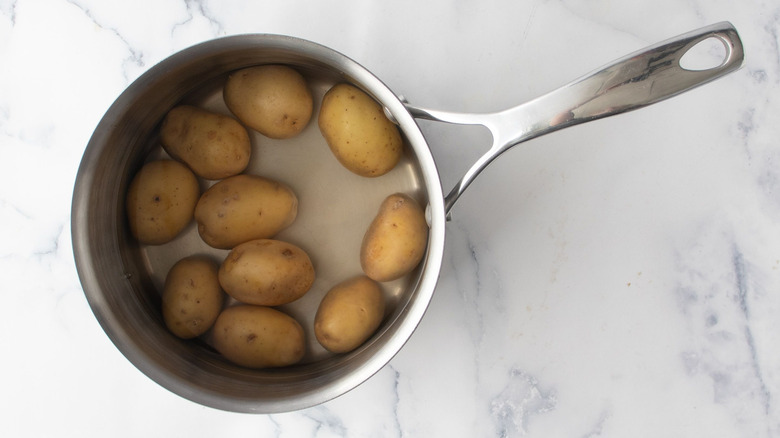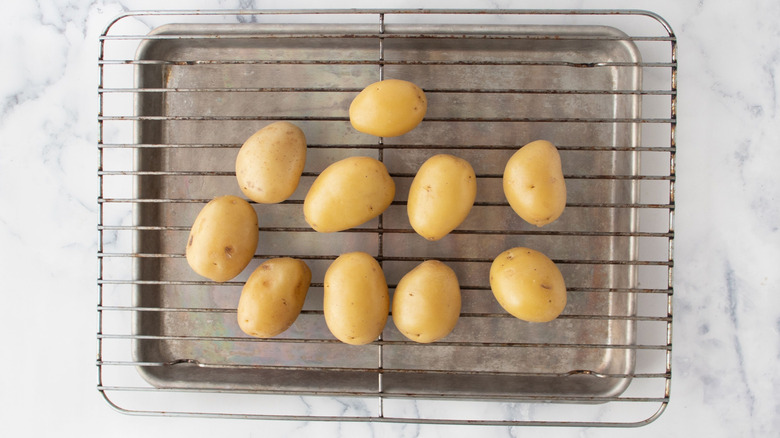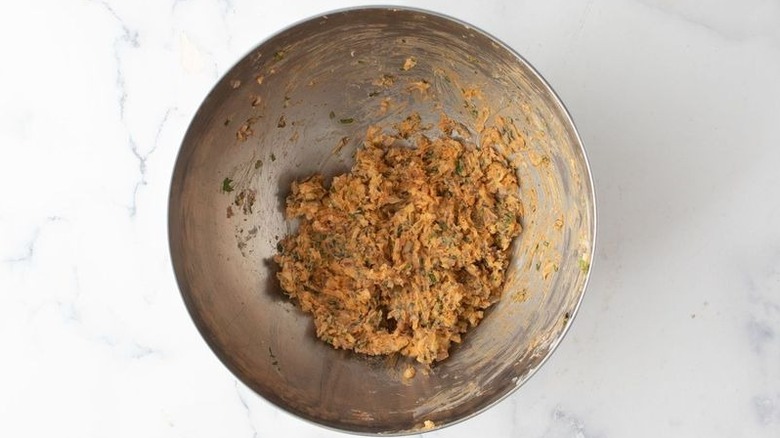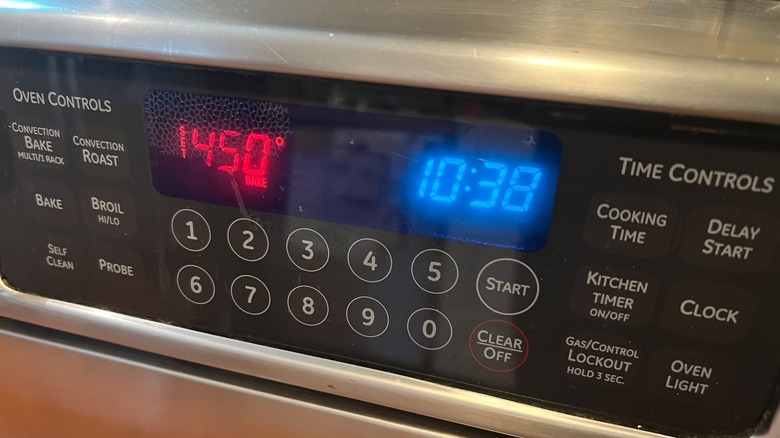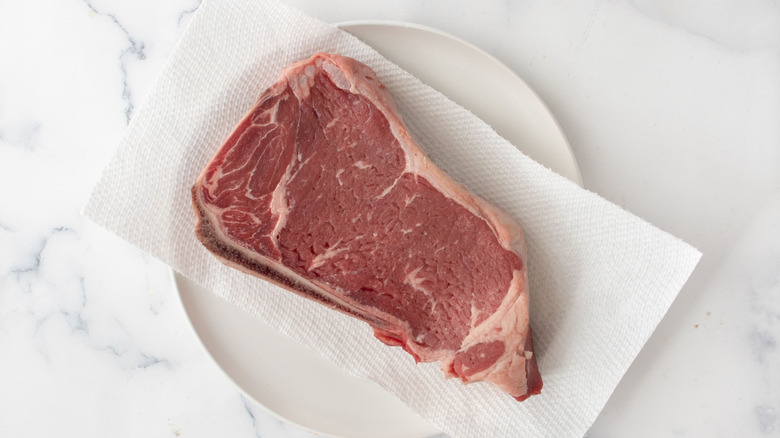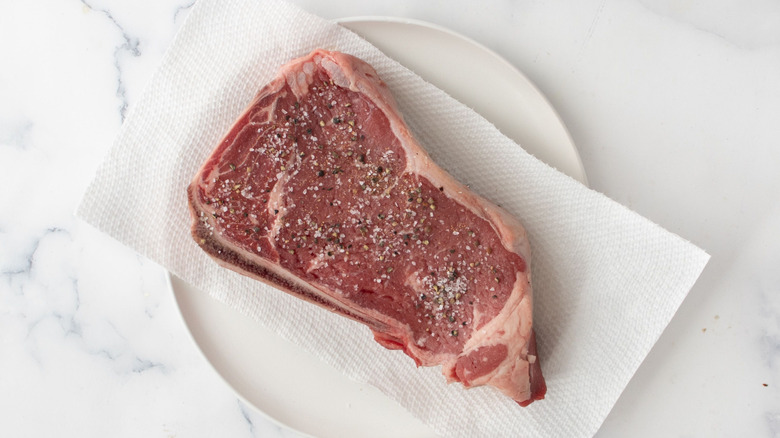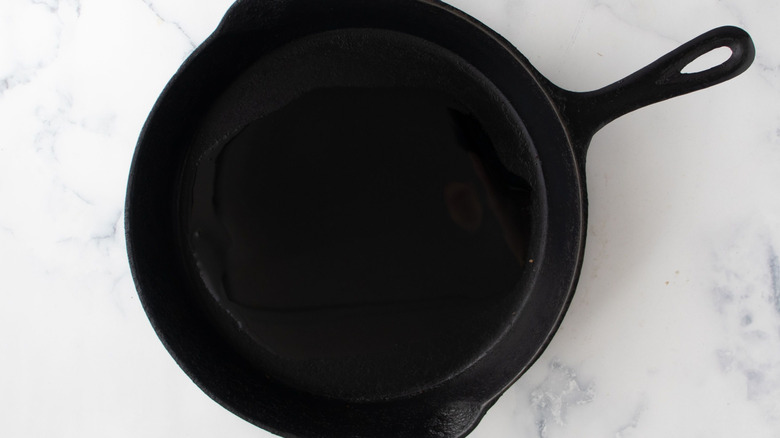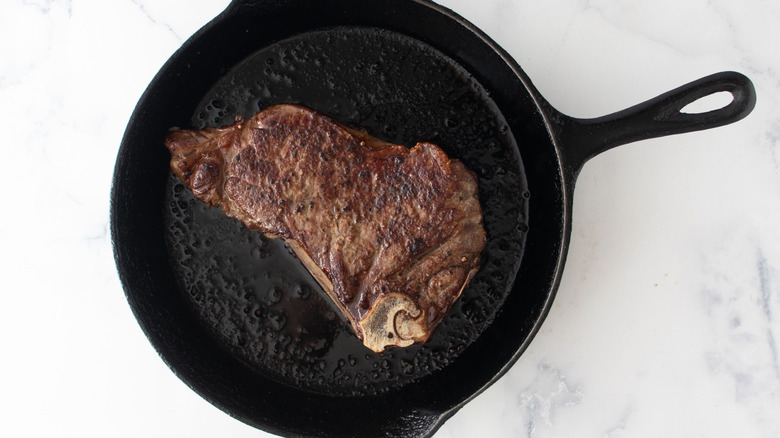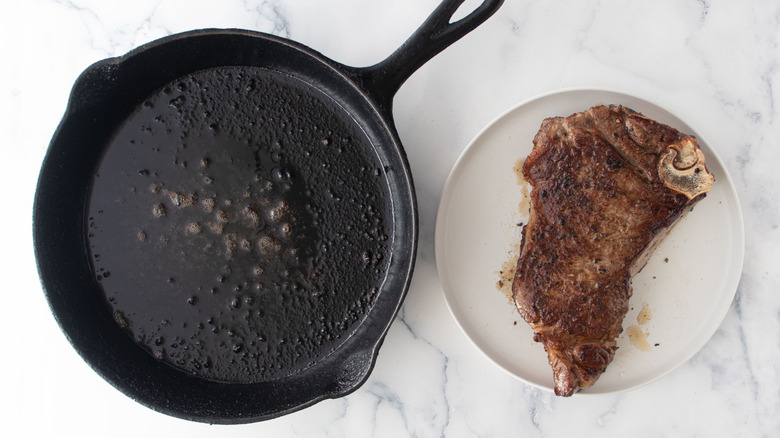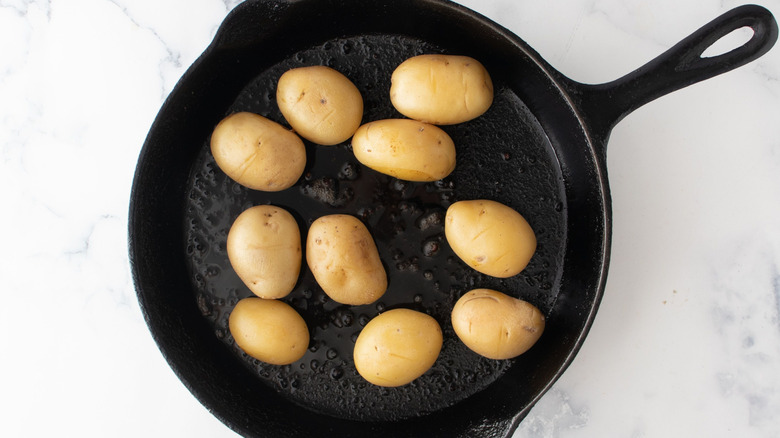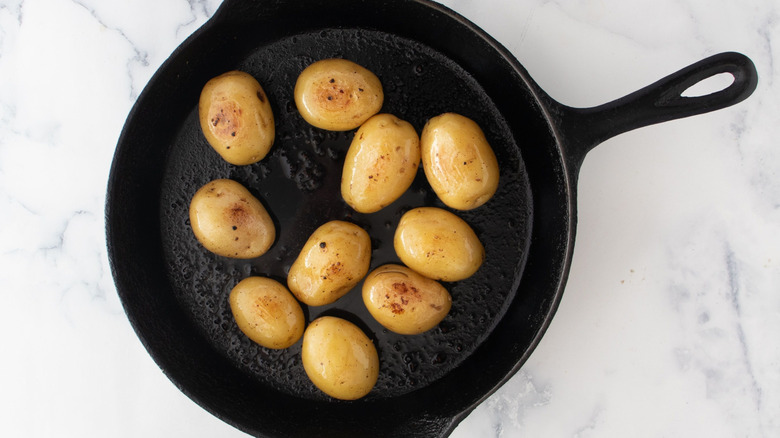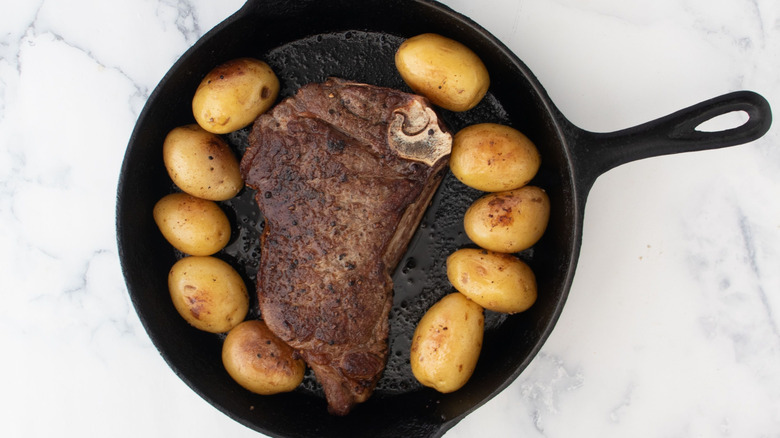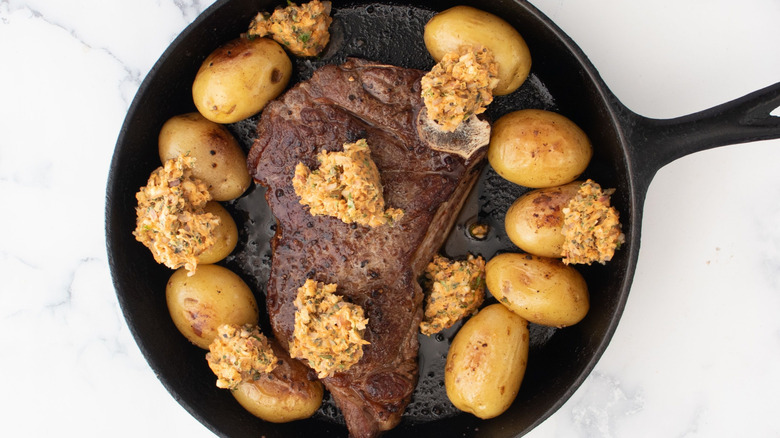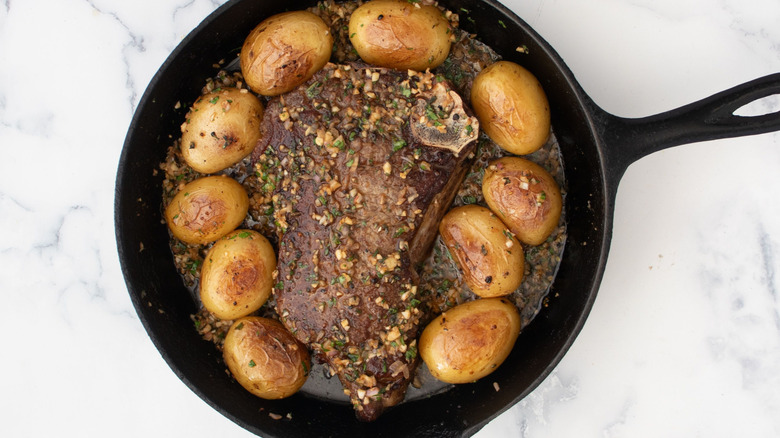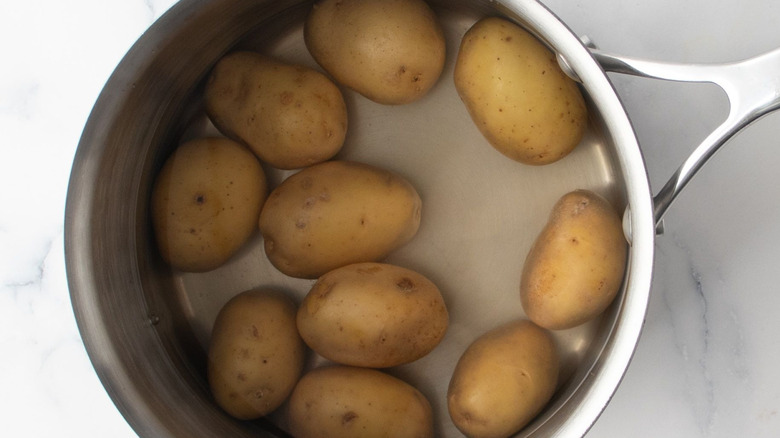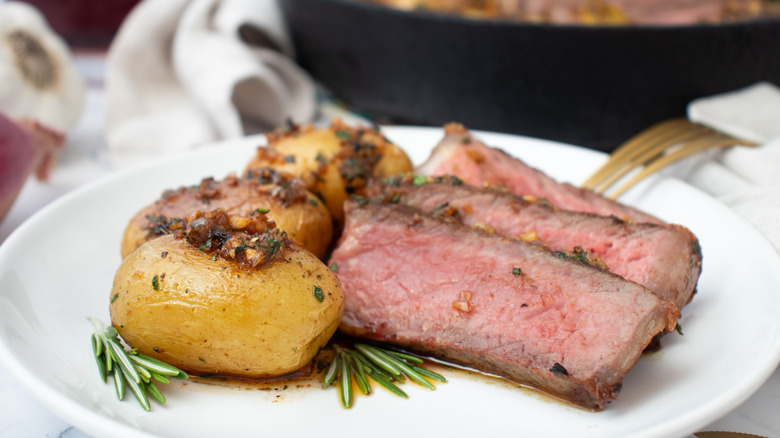Garlic Steak And Potato Skillet Recipe
It's hard to find a more tried-and-true and timeless pairing than steak and potatoes. There are quite a few ways you could prepare this classic combination, depending on what cut of steak you have on hand and what types of potatoes you're in the mood for. This garlic steak and potato skillet recipe, from developer Patterson Watkins, takes an easy-to-make yet elevated approach to the classic dish, featuring baby potatoes, bone-in strip steak, and perhaps the ultimate star of the show here, a garlicky, herb-infused compound butter.
"If you're craving a steakhouse experience at home, this is your recipe," Watkins says. And, she can't help but highlight the compound butter, which imparts an immense amount of savory flavor not only to the steak but to the potatoes, too. "That compound butter does not play around," Watkins quips, adding, "That silky savory garlicky infusion really soaks into the steak and potatoes (leaving some tasty pan drippings for further sopping as well)." Though you will build some elements of the recipe separately, everything ultimately comes together in one skillet, making for a seemingly simple dinner that teeters into decadent territory without a whole lot of extra effort.
Gather the ingredients for this garlic steak and potato skillet
For the potato aspect of this recipe, you'll need baby potatoes, apple cider vinegar, and some water to boil them in. As for steak, you'll need a bone-in strip steak, salt, pepper, and some olive oil to cook the meat in. Then, for that compound butter, you'll need softened salted butter, peeled and minced garlic cloves, a peeled and minced shallot, chopped fresh rosemary, chopped fresh thyme, chopped fresh parsley, smoked paprika, and black pepper.
Step 1: Bring potatoes, vinegar, and water to a boil
Place the potatoes in a pot and cover with water. Add the vinegar and bring to a boil over high heat.
Step 2: Par-cook then drain the potatoes
Once boiling, par-cook the potatoes for 5 minutes. Drain the potatoes and set aside to dry on a wire rack.
Step 3: Combine butter, aromatics, and herbs
Place the softened butter, garlic, shallot, rosemary, thyme, parsley, paprika, and pepper in a small bowl. Using a fork, stir and mash the butter mixture until thoroughly combined. Set aside.
Step 4: Preheat the oven
Preheat the oven to 450 F.
Step 5: Pat the steak dry
Pat the steak dry with paper towels.
Step 6: Season the steak
Season the steak with salt and pepper.
Step 7: Heat olive oil in skillet
Heat the olive oil in a large skillet over medium-high heat.
Step 8: Sear the steak
Once hot, add the steak to the skillet, and sear on all sides (including any fatty edges) until thoroughly brown, about 3 to 4 minutes per side.
Step 9: Remove the steak from the skillet
Remove the steak from the skillet and set aside.
Step 10: Add potatoes to the skillet
Add the par-cooked potatoes to the skillet and place it in the oven.
Step 11: Roast the potatoes
Roast the potatoes for 20 minutes, flipping halfway through.
Step 12: Return the steak to the skillet
Push the potatoes to the sides of the skillet and place the steak in the center.
Step 13: Add compound butter and roast again
Dollop the compound butter over the potatoes and steak and return the skillet to the oven. Roast for 5 minutes or until the butter has melted and the potatoes are fork-tender.
Step 14: Rest the steak and potato skillet before serving
Remove the skillet from the oven and set it aside to rest for 10 minutes before slicing and serving.
What can I serve with my garlic steak and potato skillet?
Tender and Juicy Garlic Steak and Potato Skillet Recipe
Silky, herby, garlicky compound butter soaks into medium-rare strip steak and tender-crispy roasted baby potatoes in our easy yet impressive skillet dish.

Ingredients
- For the potatoes
- 12 ounces baby potatoes
- 2 tablespoons apple cider vinegar
- For the compound Butter
- 4 tablespoons (½ stick) salted butter, softened
- 5 garlic cloves, peeled and minced
- 1 shallot, peeled and minced (about 2 tablespoons)
- 1 teaspoon chopped fresh rosemary
- 1 teaspoon chopped fresh thyme
- 2 teaspoons fresh chopped parsley
- ½ teaspoon smoked paprika
- ½ teaspoon black pepper
- For the steaks
- 1 (1 ¼-pound) bone-in strip steak
- 1 teaspoon salt
- ½ teaspoon black pepper
- 2 tablespoons olive oil
Directions
- Place the potatoes in a pot and cover with water. Add the vinegar and bring to a boil over high heat.
- Once boiling, par-cook the potatoes for 5 minutes. Drain the potatoes and set aside to dry on a wire rack.
- Place the softened butter, garlic, shallot, rosemary, thyme, parsley, paprika, and pepper in a small bowl. Using a fork, stir and mash the butter mixture until thoroughly combined. Set aside.
- Preheat the oven to 450 F.
- Pat the steak dry with paper towels.
- Season the steak with salt and pepper.
- Heat the olive oil in a large skillet over medium-high heat.
- Once hot, add the steak to the skillet, and sear on all sides (including any fatty edges) until thoroughly brown, about 3 to 4 minutes per side.
- Remove the steak from the skillet and set aside.
- Add the par-cooked potatoes to the skillet and place it in the oven.
- Roast the potatoes for 20 minutes, flipping halfway through.
- Push the potatoes to the sides of the skillet and place the steak in the center.
- Dollop the compound butter over the potatoes and steak and return the skillet to the oven. Roast for 5 minutes or until the butter has melted and the potatoes are fork-tender.
- Remove the skillet from the oven and set it aside to rest for 10 minutes before slicing and serving.
Nutrition
| Calories per Serving | 1,086 |
| Total Fat | 80.5 g |
| Saturated Fat | 34.2 g |
| Trans Fat | 0.9 g |
| Cholesterol | 270.3 mg |
| Total Carbohydrates | 35.4 g |
| Dietary Fiber | 4.7 g |
| Total Sugars | 2.3 g |
| Sodium | 1,237.0 mg |
| Protein | 54.0 g |
Why do you par-boil the potatoes before adding them to the skillet?
We know that any extra steps in a recipe can seem like a slog, but par-boiling the baby potatoes before roasting them is a step you won't want to miss. Even just 5 minutes of boiling time helps soften those potatoes, which means that the insides will be tender, and you don't have to cook the potatoes so long that you burn the outside. It also saves you time in the end, as it reduces the overall cooking time, all while ensuring a tender-on-the-inside, perfectly-cooked spud.
Okay, so you may be sold on the whole par-cooking thing, but why add apple cider vinegar to the mix? "Vinegar in the boiling water helps potatoes retain their shape and reduces mush," Watkins explains. "This way, when we get to the pan-roasting phase, we end up with a crispier exterior and a fluffy interior." She goes on to explain that the acidic vinegar helps slow the process in which the potatoes' sugary starches break down, meaning that once cooked, your potatoes won't be gummy or have an unpleasant texture.
As for why apple cider vinegar specifically, it turns out that many vinegars will work just fine here, but ACV is a classic option that many folks have stocked in their pantries at all times. "You want something with approx 5-8% acetic acid," Watkins says, so white or white wine vinegar, white balsamic, sherry vinegar, or even certain rice vinegars would all work here.
How can I customize the compound butter?
Steak and potatoes are great on their own, even when they're minimally seasoned, but once you introduce an herb-infused compound butter to the mix? Well, it certainly ups the dinnertime ante. Watkins opts for a very garlic-forward compound butter for her recipe, but one that also highlights herby flavors and even some smoky, peppery ones thanks to smoked paprika and black pepper. The beauty of compound butter is that it infuses a lot of flavor with little effort, and you can switch up that flavor — and the texture — in an endless variety of ways. Watkins points out that the shallots and garlic in her version make it pretty chunky, and recommends that if you want something smoother, you can process the ingredients before stirring them into the butter.
If you like things spicy, consider swapping out that sweet smoked paprika for the hot version, or switch it for something more distinctly spicy, like chili powder — Watkins recommends chipotle chili powder, which would also add a touch of smokiness. And you can branch out further from there. "You could do an Asian-inspired compound butter with garlic, lemongrass, shallot, and ginger, even a pinch of crushed Szechuan peppercorns would be cool," Watkins suggests. Or go a more Mediterranean route by introducing herbs like basil and oregano. Finally, consider a Middle Eastern or North African approach by way of cumin, coriander, cardamom, or other warming spices — as Watkins puts it, "Play on, friends. Compound butters are fun."
